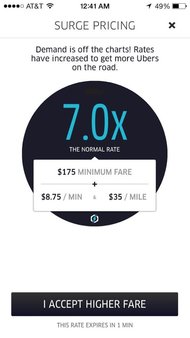Economist in NYT: Abolish corporate income tax
(Austrian) Economics, TaxationFrom one of the more unlikely corners of the interwebs — the op-ed section of the New York Times — comes a call to abolish the corporate income tax:
The United States may well have the highest effective marginal corporate income tax rate of any developed country. Jack Mintz, a public finance economist and director of the School of Public Policy at the University of Calgary, puts the rate close to 35 percent, which is also the statutory rate. Other economists, using different techniques, calculate the marginal rate to be as low as 23 percent. But both figures are miles above zero.
They are also miles above our 13 percent average corporate income tax rate — the ratio of corporate taxes to total corporate profits. The fact that the marginal tax rate, whether 23 percent, 35 percent or somewhere in between, is so much larger than the average rate suggests that a sizable share of corporate profits and production is ending up overseas and untaxed.
Making, rather than just stating, this case requires constructing a large-scale computer simulation model of the United States economy as it interacts over time with other nations’ economies, and then seeing how the model reacts when you change the American corporate income tax. I’ve developed such a model with three colleagues through the Tax Analysis Center, a nonpartisan research group. Our findings make a very strong, worker-based case for corporate tax reform.
The author, economist Laurence Kotlikoff of Boston University, argues that eliminating the corporate income tax will produce “rapid and dramatic increases in American investment, output and real wages, making the tax cut self-financing to a significant extent.” It’s an idea even President Obama embraced, at least partially — in 2012, he proposed lowering the corporate income tax a few points. Kotlikoff’s plan is considerably more radical, although he also calls for raising personal income tax rates to make up any decrease in revenues, and taxing capital gains at the same rate as income, among other reforms. Elsewhere, Kotlikoff has proposed what he calls a “Common Sense Tax” plan, which assesses a 13% flat tax on payroll and a 25% tax on personal income above $100,000.
Nobody in the mainstream press ever seems to want to propose ideas to make government do a lot less of what it does now, and thereby reduce the need for taxation, period, let alone “reform”. But talking about lowering or eliminating taxes in the Newspaper of Record is still a pretty good step forward.
Economist in NYT: Abolish corporate income tax Read Post »


 The morning after I saw “Catching Fire,” part two of the film series based on the Hunger Games novels, I was scheduled to give a lecture on the nature and functioning of the state. I had vast notes I had prepared over the previous six months for it.
The morning after I saw “Catching Fire,” part two of the film series based on the Hunger Games novels, I was scheduled to give a lecture on the nature and functioning of the state. I had vast notes I had prepared over the previous six months for it.